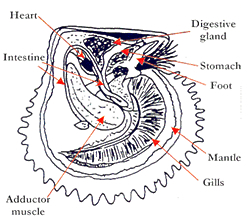Send oysters to the Biosecurity Sciences Laboratory
If you have sick or dying oysters that need to be submitted for examination and diagnosis by an aquatic animal pathologist, follow the instructions listed below.
Select 6 or more oysters typical of the problem; a sample from each raft, longline or tank should be submitted. If larvae or spat are affected, send 60 or more.
How to send live oysters
- Place larvae and spat in plastic bags containing moistened paper or rag towelling, fill the bags (preferably with oxygen) and seal. Place this bag in a second bag and seal.
- Wrap adult oysters in damp paper or cloth and place in an aquaculture-standard coolite container or similar protective box.
- Complete the specimen advice sheet and attach it in an envelope to the exterior of the specimen box.
- Contact the laboratory and advise them how and when the oysters are coming.
How to prepare preserved oysters

If it is difficult to send live oysters, you can send preserved oysters.
The preservative used is 10% seawater saline (for marine specimens):
- formalin (37–40% w/v formaldehyde solution) 100mL
- seawater 900mL.
Always wear gloves and protective eye wear when handling preservatives.
Preparing larvae or spat
When sending larvae or spat, place 60 or more directly into the preservative.
Preparing juvenile oysters
When sending juvenile oysters up to 10cm (dorso-ventral shell size), remove the soft tissues (as a group) from each shell, cut into the middle of these tissues, and place in preservative.
Preparing adult oysters
There are 2 accepted methods for preparing adult oysters to be sent.
Method 1
- Remove 1 shell valve by cutting the tissues close to the inside of that shell valve.
- Make 1 or 2 deep cuts into the tissues to allow preservative to enter and fix the tissues more rapidly.
- Remove all the tissues from the second valve and place in preservative. If the containers are not large enough to hold the whole oyster, cut the oyster in half and place half in each of 2 containers.
Method 2
- Chock open the oyster.
- Using a large knife, cut the oyster tissues in half by bringing the knife down between the 2 open shell valves (e.g. as when harvesting half pearls).
- Remove the oyster tissues from each shell valve and place in preservative.
- If there is insufficient room in 1 container, place half of the oyster in 2 separate containers or preserve and send only 1 half of the oyster.
Preparing oyster tissues
Generally, for good preservation, tissues should not be thicker than 5mm. Place tissues in 10 times their volume of preservative and remove after 5–7 days.
How to send preserved oysters
Once you have prepared your preserved oyster, you need to package them appropriately to be sent.
Use the following steps:
- Place oyster specimens into a plastic bag, remove excess air and seal with heavy packing tape. There should be no free fluid in the bag. A piece of paper towelling or cloth may be placed in the bag with the oyster specimens to keep them moist and to absorb any free seawater formalin.
- Place the bag and oyster specimens into a second plastic bag, remove excess air and seal with heavy packing tape. There should be no smell of formalin from the package.
- Label each bag if more than 1 lot of oyster specimens is to be sent in the same box.
- Place labelled bags containing the oyster specimens into a strong cardboard or aquaculture-standard coolite box. Add packing to prevent oyster specimens being damaged during transport.
- Complete the specimen advice sheet, place it in an envelope and attach it to the exterior of the box containing the specimens.
- Contact the relevant Aquatic Pathologist or Veterinary Officer before sending samples to the appropriate laboratory, as listed below.
Submitting samples
Contact the Duty Pathologist before sending samples.
Routine aquatic animal samples
Submit routine aquatic animal samples for testing to:
Biosecurity Sciences Laboratory (BSL)
Health and Food Sciences Precinct
Specimen receipt (Loading Dock 12)
39 Kessels Road
COOPERS PLAINS QLD 4108
Phone: (07) 3708 8762 (Aquatic Pathologist – submission enquiries)
Further assistance
If you need further assistance, contact us online, by phone or in person.